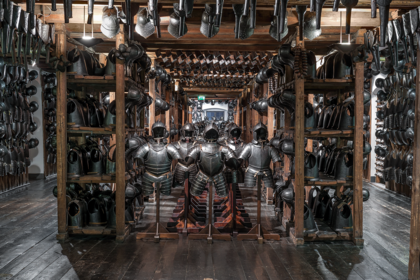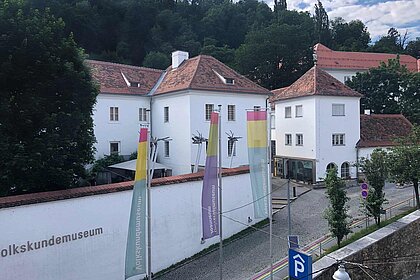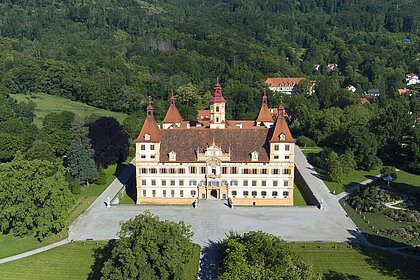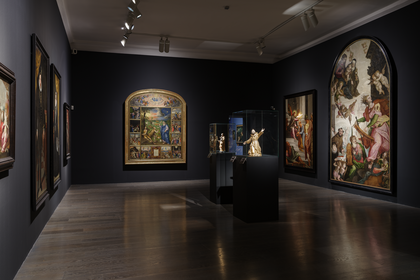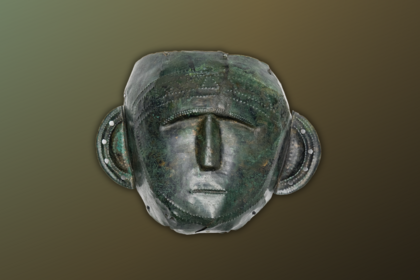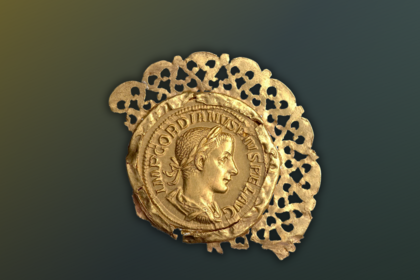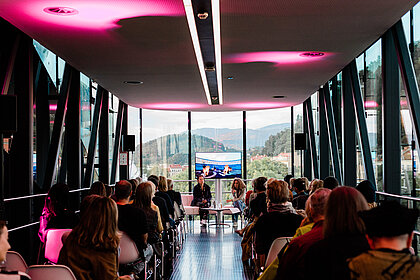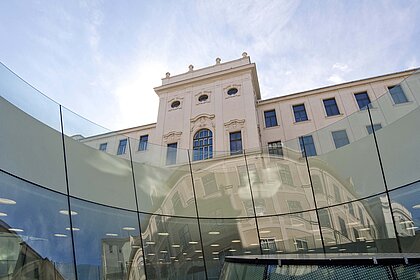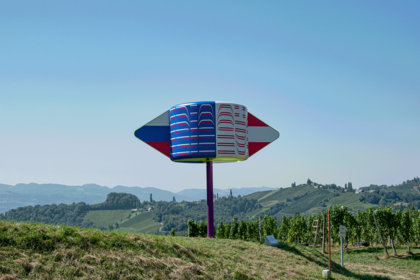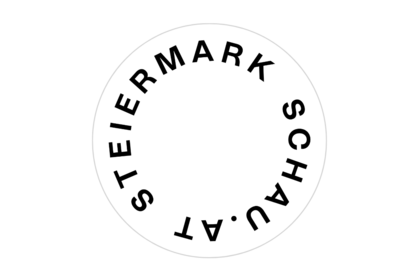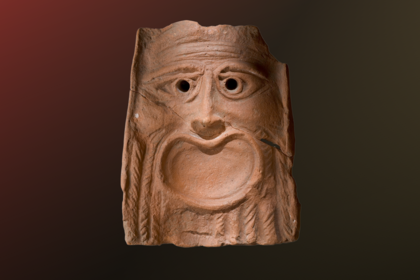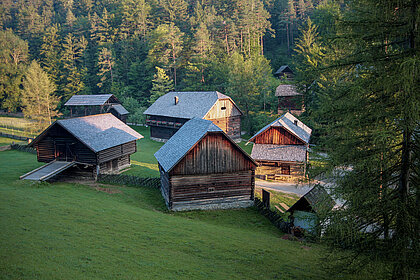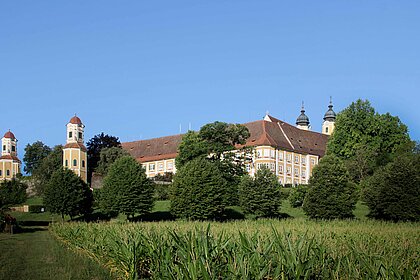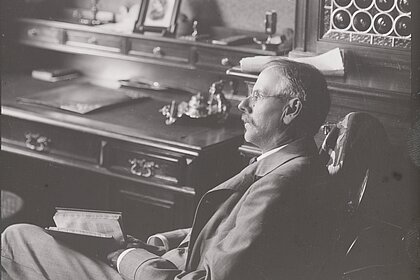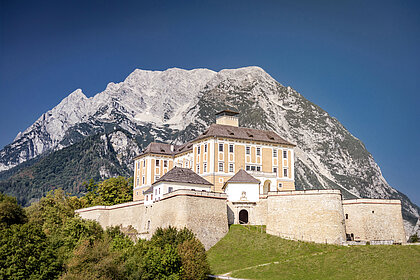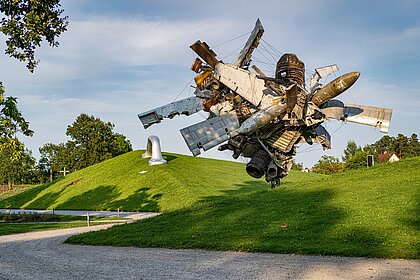The preservation of the collection and of the historical building is now one of the central tasks of the Styrian Armoury.
Behind the scenes at the armoury
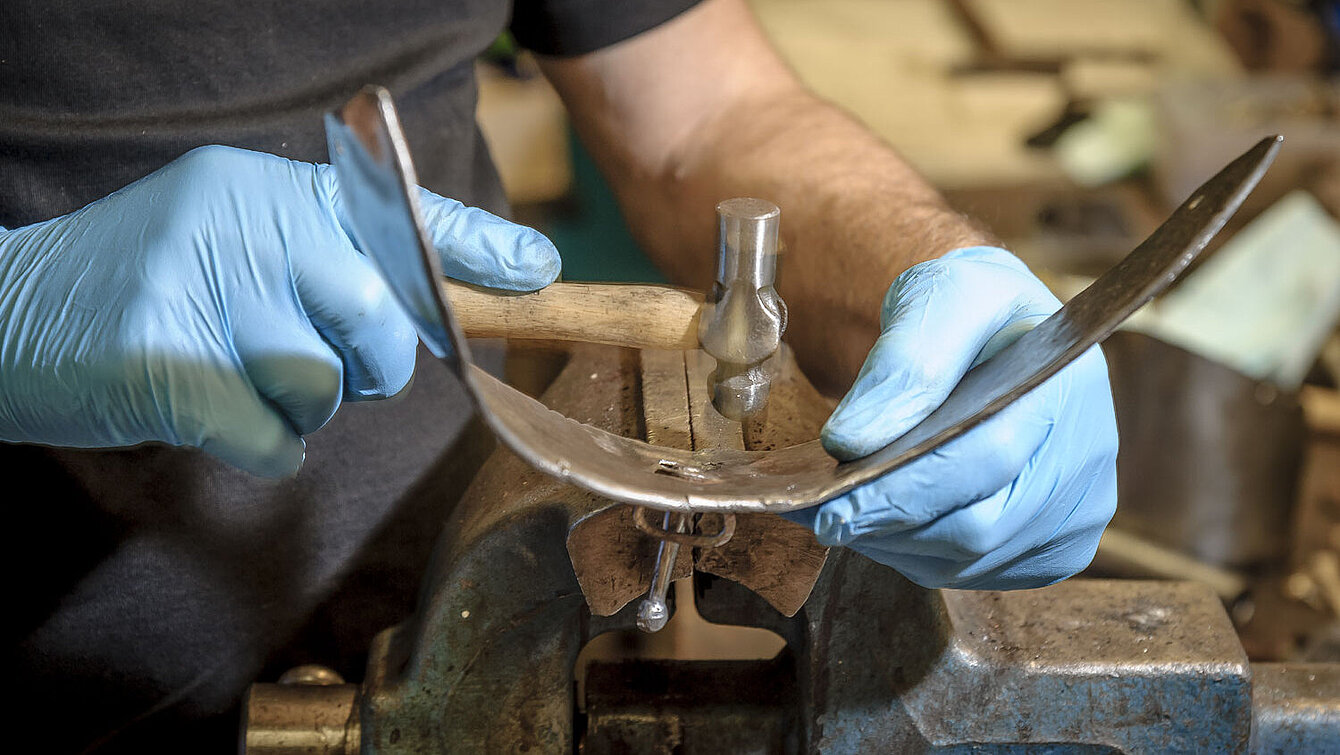
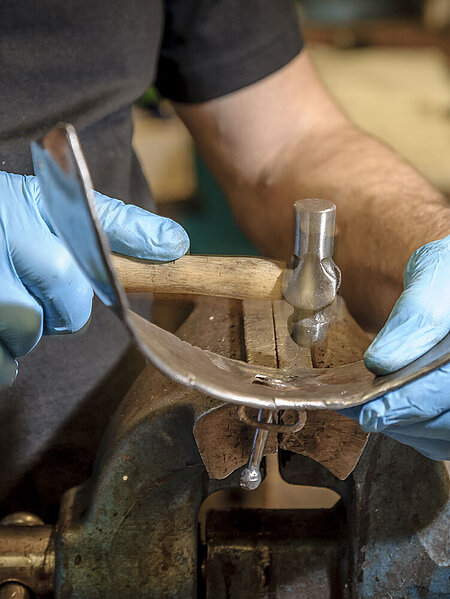
Image Credits
Conserving, examining, restoring
Daniela Assel, Leonardo Loof, Maximilian Mischinger and Thomas Storm in conversation with Bettina Habsburg-Lothringen
Bettina Habsburg-Lothringen: The Styrian Armoury is not just a site of interest for visitors – it’s also a place of work. Every day a small group of experts work hard behind the scenes to maintain the armoury as we know it. Let’s go from big to small: Thomas Storm, whenever we see or talk to each other it is to discuss – either directly or indirectly – the Styrian Armoury as a building and issues around technology, security or monument protection. What exactly are your tasks as part of the Styrian Armoury team, and what does that mean on a day-to-day basis?
Thomas Storm: Since I joined the Styrian Armoury my role has included not just the restoration and conservation of objects but also the upkeep of the museum building as a whole. For this I work closely with the team of the Facility Management section at the Universalmuseum Joanneum. I coordinate the companies who are entrusted with maintaining a range of technical systems such as video surveillance or the lift. Finally, I also answer questions on a wide variety of topics related to the weapons.
It must be a constant challenge to reconcile a structure built in the 17th century with the needs of the present day: adapting a non-electrified, unheated arms depot with access restricted to just a handful of people into a major museum operation with specific safety and accessibility requirements. That sounds complicated! What are the particular issues involved?
Thomas Storm: What’s unusual about the Styrian Armoury is that it is a historic building that was created with a very specific function in mind – to store weapons and armour in large quantities so that they could be issued quickly if needed. As you mentioned, during the 17th century the armoury operated mainly as a closed place of work accessed only by a few experts. So there were no facilities or space for the public. There was also no electric lighting, no heating, no air conditioning. Nowadays the situation is very different: we need constant financial resources and expertise so that we can take care of the building, which has been conserved thanks to enormous dedication over the centuries. The Monuments Office stipulates that we can only use craftspeople and companies familiar with historical techniques. At the same time, a lot has happened in recent years in terms of technology and security. It takes more than just money to bring the building up to the latest standards. The introduction of facilities that meet today’s criteria must be carried out as discreetly as possible so as to preserve the original atmosphere. Which is not always easy to do, since we also have to take safety into consideration, together with the quality of visitor experience we offer. An example of this from the last few years was the installation of the lift, which was important and necessary in terms of accessibility, but also represented a major intervention in a historic building. In the end the solution we found was to house the lift in the building next door!
When we talk about the ‘Styrian Armoury’, we don’t just mean the historic building – it also includes the many thousands of objects inside. Leonardo Loof, as a restorer you are responsible for these. What exactly are your tasks, and what does your day-to-day work involve?
Leonardo Loof: Our job as restorers is to maintain and preserve the collection. We are a small team looking after some 30,000 objects. It would be easy to lose track of them due to their sheer number, which is why we organise the collection according to object and material focuses. Fortunately, a lot has been done since the armoury was closed and made into a museum. But the work never stops. During our regular inspections of the four storeys we check on the condition of the collection. Is something hanging askew? Is a strap broken? Can we see any other damage? This allows us to react quickly to changes in individual objects or their display alongside our ongoing focus-based work. Whenever we spot some damage, we take the item in question to the workshop. Here the first step is to make a photographic and written record. The cause of the damage is analysed and we discuss a plan for its restoration. This can range from simple repairs, for example to an armour strap, to the complex restoration of a two-handled hilt made of various different materials.
From a restorer’s point of view, what difference does it make working at the Styrian Armoury as opposed to a traditional museum?
Leonardo Loof: The profession of restorer involves a lot of responsibility. You are literally reaching your hand into the past. One slip of the hand or the wrong treatment can result in major damage to the object. The Styrian Armoury is made up of a unique constellation. It is different from a traditional museum in that most of its collection is accessible to the public. In a conventional museum, normally only a small selection is on show, while the rest of the objects are kept in storage at an ideal climate. In other museums the objects are protected inside display cases, whereas our objects are kept out in the open on racks, hung on the walls and from the ceiling. As Thomas Storm explained just now, our collection is housed in a historic building without air conditioning, which is why we try to keep the indoor temperature constant by airing the space or closing the shutters. Unfortunately, dust comes in through the windows and is brought in by the many visitors, meaning that the collection has to be cleaned continuously.
We will come back to this again later. For the moment let’s take a look at the features of the collection. When you come into the armoury, the impression you get is that the objects are very uniform, identical even. The eye sees metal. Does that make your work simpler?
Leonardo Loof: The Styrian Armoury is famous for its vast collection of edged weapons, armour and firearms. The first material to catch your eye is, of course, metal. But most of the items are also made of organic materials such as wood, leather, textiles, horn and bone. For us restorers this represents a particular challenge, since we have to constantly monitor changes in humidity and temperature that can affect these materials in various ways. Corrosion – that is, rust – is a major issue that we have to tackle with constant care. In order to protect the objects we ask our visitors not to touch them, since every contact of this kind results in a spot of rust.
But the most serious damage occurs in the organic materials: leather, for instance, can disintegrate over time as a result of sulphur in the air. The UV rays of the sun are especially harmful for textiles, while wood, bone and horn can crack and break due to strong fluctuations in climate. The knowledge and expertise about objects that restorers bring to museums is very different from the contribution made by a historian or cultural educator. How does one become a restorer?
Leonardo Loof: There are two educational paths that can lead to the restoration workshop here at the Styrian Armoury. The first path is the traditional way via the crafts. This is also the traditional path because platers, locksmiths and gunsmiths have been employed to mend the equipment ever since the armoury building was first completed. Many of our predecessors changed career from these professions, bringing their expertise with them and also learning how to handle the historical objects at the armoury. Certain work techniques such as the expert dismantling of a wheel lock have been handed down to the next generations since then. The other path is through studying at university or college, where practice-based training in restoration is an integral part of the course. This goes hand in hand with theory and a relevant background in chemistry. It is important to understand the materials of an object in precise detail so as to avoid any harmful effects. Over the last few decades there have been many advances in restoration methods, and this includes the armoury. When it comes down to the fundamentals of the collection, however, we have mostly continued the well-tried practices. Craft and academic restoration complement each other in their approaches and the techniques available. Generally speaking, for a career in restoration you need an aptitude for manual craftsmanship, an interest in historical objects and a willingness to learn and constantly improve.
Maximilian Mischinger, this fits in very well with your professional background. You are a trained historian and now work on the restoration team. Much of your everyday life is spent directly in the armoury rather than the workshop – what shapes your daily routine?
Maximilian Mischinger: I take care of the Landsknecht armour, the flintlock and wheellock rifles, vambraces and leg tassets, usually in situ. I check over the leather straps which sometimes need to be replaced because of their condition. I generally look at the condition of the objects and make adjustments to various components. I am especially careful when handling the objects – even when I take them from the shelves to oil them. With the muzzleloaders, for instance, you have to take care that nothing breaks when you take them from the rack.
And how exactly do you go about being responsible for 32,000 objects? Do you need to use a specific system? And how much time can you invest per object, given the huge number of them?
Maximilian Mischinger: You do need an ‘iron will’. What I do is to divide the groups of objects up into problem zones, with the top priority being the ones showing signs of damage. If I work floor by floor the risk is that I will lose the overview. Details are important, otherwise you can overlook things that are in a serious state or have already lost some material. If the object is badly damaged it is taken straight to the workshop. As for how long it takes for each individual object, you can’t really generalise, but if you take the example of a muzzleloader, say, it would be five to seven minutes from checking it over through to oiling.
The Styrian Armoury is a very special place to work, especially when you consider that there is no heating or air conditioning in here. So in winter it is cold, while in summer we often measure over 30 degrees in the rooms. Are these temperatures the greatest challenge?
Maximilian Mischinger: The temperatures are a challenge for the objects but not for me. Particularly as I also have the option to do the work in the workshop. The same applies to guests always touching the objects – the rust patches are more of a problem for the objects than for me. I view “challenges” in a positive way and associate them with studying a wide range of literature for personal development.
Being directly present in the armoury means that you, unlike your colleagues in the workshop, are visible to the public. Does this lead to questions and conversations?
Maximilian Mischinger: Yes, all the time! The questions can vary a lot, such as “What would you recommend for restoring my own objects?” Many of the visitors are also interested in the cultural and historical features, so for instance if they notice the etchings on the armour they want to find out more about them. But by far the most common question is: “What are you doing?”
When you work in a place like the armoury, you are part of a history: generations of people have taken care of the objects before you. You learn from your predecessors, carry on their work, give up some things, try out new things. Specifications, standards and expectations change. Thomas Storm, you have been entrusted with the armoury for a long time now: what has changed for you in the last few years and decades? What has become more complex, are there perhaps some things that have become simpler?
Thomas Storm: A lot has changed, basically! The technology has grown more complex but, as we mentioned before, its use must always comply with conservation requirements. Many things can now be controlled by computer, such as the underfloor heating in the cannon hall.
As far as the temperature and humidity in our rooms are concerned, we do not have any air conditioning but we do make use of current technical solutions to closely monitor the natural climate and we have developed strategies throughout the year to take various measures in terms of protecting the objects. In the last few decades a great deal of research has been done into material behaviour and environmental requirements. New data and findings have shown that allowing broader climatic conditions does not pose a threat to most collections. The Bizot Group – a group founded in 1992 that brings together the world’s largest museums at regular intervals – now recommends values between 16 and 25°C at 40- 60% humidity. This used to be much more narrowly defined. One area, of course, where we have to watch out for changes is legislation: Austria has a Weapons Act that clearly regulates the possession of firearms for private individuals, including the minimum age of the owner, compulsory registration, storage, etc. In Austria, weapons made before 1871 are considered historical weapons and the armoury’s collection falls into this category.
Leonardo Loof, you haven’t been with the team for very long: how do you gain knowledge?
Leonardo Loof: Yes, that’s right, I have only been here since 2021. Compared to my colleagues that is not long. I came here straight from university in Germany and didn’t know what to expect. I have learned something new every day. Specialist literature can of course help with understanding a restoration problem. You rarely find detailed instructions on how to solve it, however. You often also spend a lot of time checking whether what you have read might already be outdated. There is a lot that you have to try out and compare for yourself. In this context, colleagues from the same or other specialist areas who can give you help and advice are invaluable sources of knowledge. My colleague Thomas Köhler in particular, who worked at the armoury for over 35 years, passed on a great deal of knowledge to me along the way. If we take a look at the work carried out over the last few decades we can see that standards and approaches to restoration change all the time: undoing restoration that was well intentioned but, from today’s point of view, inappropriate can indeed be a challenge. During the 1960s, for instance, many two-handed sword handles were painted with a black varnish, including the leather and fabric, which obscures and distorts the surface. But the varnish can only be removed by using very aggressive solvents that would seriously damage the original material underneath. Against the background of this kind of experience we now make sure that we work with reversible materials so that if necessary we can remove them again from the objects and so preserve them for future generations.
Maximilian Mischinger: Working at the Styrian Armoury involves building on experience and handing knowledge down to the next generation. Personally, it is what I most like about my job: working with young interns who want to gain experience in how to handle objects, and exchanging ideas with them. Above all I like showing them how you can improve your “craftmanship” and how to hold the items so that they don’t get damaged. The most important thing is accuracy, even down to the millimetre.
Working at the Styrian Armoury doesn’t just mean working directly with the building or the objects. Daniela Assel, many of your tasks relate to both indirectly, however. As a sociologist, what is the focus of your daily work?
Daniela Assel: My responsibilities include managing the collection and the library, handling requests for loans, photos and filming, maintaining the website and social media. I’m also involved in producing printed materials, answering various enquiries about our collection and keeping an eye on the budget. My duties are quite varied, so I have to structure my working day well, but also stay flexible.
What does managing this kind of collection involve, how does it work?
Daniela Assel: In practical terms, this means above all that I know the “whereabouts” of each object: the location of an item in the armoury, whether it is currently out on loan or being restored. The means that the location register must be constantly updated. Maintaining the object database is also part of this process, there are many things that do not yet have a digital record and are gradually being added to the database, with the help of students and interns too. Apart from loaning individual objects to museums or exhibitions, we also receive a lot of requests to use images in a range of publications. This requires written authorisation – given the sensitivity of the items in our collection, we want to know the context in which the Styrian Armoury will appear. It also allows us to document where we have been featured. The same applies to enquiries about filming.
In connection with the appearance of our collections at other museums, it is perhaps worth mentioning that the Styrian Armoury has often been featured as part of major international exhibitions in the last few decades. Thomas Storm, you were largely responsible for this. What is involved if an item from the armoury is shown in Osaka or Baku?
Thomas Storm: First of all, it starts off with choosing the objects – we have to be clear which can “travel” and which might need to be restored beforehand. That is a time factor. Once the items have been chosen, I get them ready. This means that each of them is cleaned, conserved and then photographed. A complete documentation of the objects, their condition and any possible “damage” is made in what are known as “condition reports”. The objects are then packed and I accompany them as a courier to the exhibition venue. This is often challenging – you can end up spending the whole night on the airfield of a cargo airport while the crates of objects are loaded. On arrival, the objects are inspected by the team of restorers in charge there. Every single condition report is signed. This is to confirm that the items were received in the documented condition. Another part of my job on site is installing all of the mounting fixtures that I have custom made for each item before departure.
Daniela Assel, what else is required for this kind of project to go ahead and to make sure that the objects travel to and from a location safely?
Daniela Assel: The large-scale international exhibitions involving several hundred objects, which we have often had, are an enormous effort in terms of administration: starting with all the communication and correspondence, the long lists of objects, the negotiations with borrowers through to insurance, transport and export licences. Preparations begin a long time before the exhibition itself. If you want to take objects abroad you need an export licence from the Federal Monuments Office. If they are travelling to a non-EU country you also have to apply for a customs procedure from the relevant customs administration. You also need to take out a “nail-to-nail” insurance policy. This means that the object is insured from the time it is removed from the collection through to when it returns.
Finally – perhaps we should come back to the armoury and your area of work: Daniel Assel, you also look after the library and are the contact person for events and the temporary art and exhibition projects that we sometimes present.
Daniela Assel: Yes, exactly, firstly I am in charge of the library – I take care of our small but select collection of literature on the various groups of weapons and catalogues from comparable collections and museums, which is based on a gift from the art historian and weapons expert Bruno Thomas. During the 20th century he was a pioneer in the field of historical weaponry. Over the decades the collection has been expanded to include books about the history of defence in Styria. I also make sure that we purchase the latest publications on weapons and current literature on restoration.
As far as events and temporary projects at the armoury are concerned, we always start by asking ourselves the basic question of whether the planned content would fit in. We do not see ourselves as a pure event location. It is important to consider that the armoury is a listed building and so there are very specific rules involved. Drilling holes in a wall or quickly hammering a nail in somewhere – that’s something we could never allow here. At the end of the day, we want to be able to pass the armoury on to the next generation in top condition!
And on that note, thank you very much for the interview!
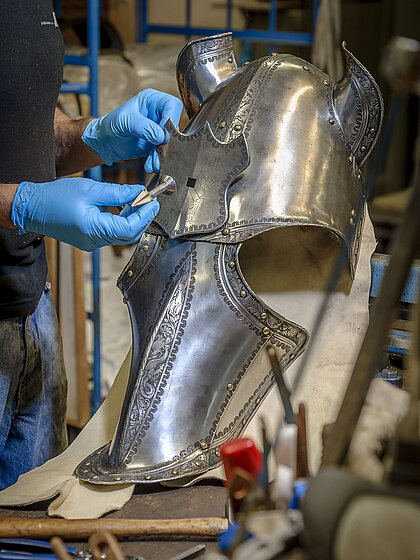
Image Credits
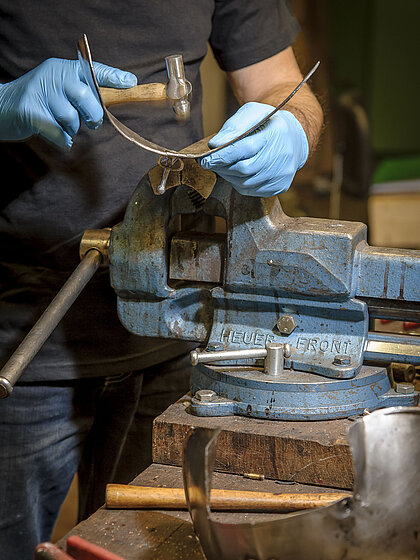
Image Credits
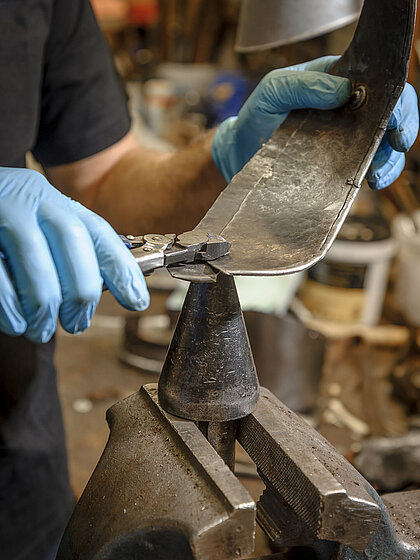
Image Credits
